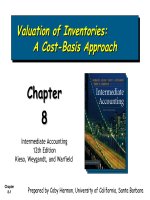Intermediate accounting 12th edition kieso warfield chapter 07
Bạn đang xem bản rút gọn của tài liệu. Xem và tải ngay bản đầy đủ của tài liệu tại đây (451.18 KB, 61 trang )
Cash
Cash and
and Receivables
Receivables
Chapter
7
Intermediate Accounting
12th Edition
Kieso, Weygandt, and Warfield
Chapter
7-1
Prepared by Coby Harmon, University of California, Santa Barbara
Learning
Learning Objectives
Objectives
1.
Identify items considered as cash.
2.
Indicate how to report cash and related items.
3.
Define receivables and identify the different types of
receivables.
4.
Explain accounting issues related to recognition of accounts
receivable.
5.
Explain accounting issues related to valuation of accounts
receivable.
6.
Explain accounting issues related to recognition of notes
receivable.
7.
Explain accounting issues related to valuation of notes receivable.
8.
Explain accounting issues related to disposition of accounts and
notes receivable.
9.
Describe how to report and analyze receivables.
Chapter
7-2
Cash
Cash and
and Receivables
Receivables
Cash
What is cash?
Management and
control of cash
Reporting cash
Summary of cashrelated items
Chapter
7-3
Receivables
Recognition of accounts
receivable
Valuation of accounts
receivable
Recognition of notes
receivable
Valuation of notes
receivable
Disposition of accounts
and notes receivable
Presentation and
analysis
What
What is
is Cash?
Cash?
Cash
Most liquid asset
Standard medium of exchange
Basis for measuring and accounting for all items
Current asset
Examples: coin, currency, available funds on
deposit at the bank, money orders, certified
checks, cashier’s checks, personal checks, bank
drafts and savings accounts.
Chapter
7-4
LO 1 Identify items considered as cash.
Management
Management and
and Control
Control of
of Cash
Cash
Management faces two problems:
(1) to establish proper controls to prevent any
unauthorized transactions, and
(2) to provide information necessary to the proper
management of cash on hand and cash
transactions.
Companies need effective internal control over
cash.
Chapter
7-5
LO 1 Identify items considered as cash.
Reporting
Reporting Cash
Cash
Restricted Cash
Companies segregate restricted cash from “regular”
cash for reporting purposes.
Examples, restricted for:
(1) plant expansion, (2) retirement of long-term debt, and
(3) compensating balances.
Illustration 7-1
Chapter
7-6
LO 2 Indicate how to report cash and related items.
Reporting
Reporting Cash
Cash
Bank Overdrafts
When a company writes a check for more than the
amount in its cash account.
Generally reported as a current liability.
Offset against cash account only when available
cash is present in another account in the same
bank on which the overdraft occurred.
Chapter
7-7
LO 2 Indicate how to report cash and related items.
Reporting
Reporting Cash
Cash
Cash Equivalents
Short-term, highly liquid investments that are both
(a) readily convertible to cash, and
(b) so near their maturity that they present
insignificant risk of changes in interest rates.
Examples: Treasury bills, Commercial paper, and
Money market funds.
Chapter
7-8
LO 2 Indicate how to report cash and related items.
Receivables
Receivables
Claims held against customers and others
money, goods, or services.
Oral promises of the
purchaser to pay for
goods and services sold.
Accounts
Accounts
Receivable
Receivable
Chapter
7-9
for
Written promises to pay
a sum of money on a
specified future date.
Notes
Notes
Receivable
Receivable
LO 3 Define receivables and identify the different types of receivables.
Receivables
Receivables
Nontrade Receivables
Examples:
1.
Advances to officers and employees.
2. Advances to subsidiaries.
3. Deposits to cover potential damages or losses.
4. Deposits as a guarantee of performance or payment.
5. Dividends and interest receivable.
Chapter
7-10
LO 3 Define receivables and identify the different types of receivables.
Recognition
Recognition of
of Accounts
Accounts Receivables
Receivables
Trade
Trade Discounts
Discounts
Reductions
Reductions from
from the
the list
list
price
price
Not
Not recognized
recognized in
in the
the
accounting
accounting records
records
Customers
Customers are
are billed
billed net
net
of
of discounts
discounts
Chapter
7-11
10 %
Discount
for new
Retail
Store
Customers
LO 4 Explain accounting issues related to recognition of accounts receivable.
Recognition
Recognition of
of Accounts
Accounts Receivables
Receivables
Cash
Cash Discounts
Discounts
Inducements
Inducements for
for prompt
prompt
payment
payment
Gross
Gross Method
Method vs.
vs.
Net
Net Method
Method
Chapter
7-12
Payment
terms are
2/10, n/30
LO 4 Explain accounting issues related to recognition of accounts receivable.
Recognition
Recognition of
of Accounts
Accounts Receivables
Receivables
Example: On June 3, Benedict Corp. sold to Chester Inc.,
merchandise having a sale price of $5,000 with terms of
2/10,n/60, f.o.b. shipping point. On June 12, Benedict
received a check for the balance due from Chester. Prepare
required journal entries assuming Benedict records the sale
at gross.
Gross Method
June 3
Accounts receivable
5,000
June 12
Sales
5,000
Cash ($5,000 x 98%)
4,900
Sales discounts
Accounts receivable
Chapter
7-13
100
5,000
LO 4 Explain accounting issues related to recognition of accounts receivable.
Recognition
Recognition of
of Accounts
Accounts Receivables
Receivables
Example: On June 3, Benedict Corp. sold to Chester Inc.,
merchandise having a sale price of $5,000 with terms of
2/10,n/60, f.o.b. shipping point. On June 12, Benedict
received a check for the balance due from Chester. Prepare
required journal entries assuming Benedict records the sale
at net.
Net Method
June 3
Accounts receivable
4,900
June 12
Sales
4,900
Cash
4,900
Accounts receivable
4,900
Chapter
7-14
LO 4 Explain accounting issues related to recognition of accounts receivable.
Recognition
Recognition of
of Accounts
Accounts Receivables
Receivables
Example: On June 3, Benedict Corp. sold to Chester Inc.,
merchandise having a sale price of $5,000 with terms of
2/10,n/60, f.o.b. shipping point. On June 29, Benedict
received a check for the balance due from Chester. Prepare
required journal entries assuming Benedict records the sale
at net.
Net Method
June 3
Accounts receivable
4,900
June 29
Sales
4,900
Cash
5,000
Accounts receivable
4,900
Sales discounts forfeited
Chapter
7-15
100
LO 4 Explain accounting issues related to recognition of accounts receivable.
Recognition
Recognition of
of Accounts
Accounts Receivables
Receivables
Nonrecognition of Interest Element
A company should measure receivables in terms of
their present value.
In practice, companies ignore interest revenue
related to accounts receivable because the amount
of the discount is not usually material.
Chapter
7-16
LO 4 Explain accounting issues related to recognition of accounts receivable.
Accounting
Accounting for
for Accounts
Accounts Receivable
Receivable
How
How are
are these
these accounts
accounts presented
presented on
on the
the Balance
Balance
Sheet?
Sheet?
Accounts Receivable
Allowance for
Doubtful Accounts
Beg.
500
25
Beg.
End.
500
25
End.
Chapter
7-17
LO 4 Explain accounting issues related to recognition of accounts receivable.
Assets
Assets
Current
CurrentAssets:
Assets:
Cash
Cash
Accounts
Accountsreceivable
receivable
Less
Lessallowance
allowancefor
fordoubtful
doubtfulaccounts
accounts
Inventory
Inventory
Prepaids
Prepaids
Total
Totalcurrent
currentassets
assets
Fixed
FixedAssets:
Assets:
Office
Officeequipment
equipment
Furniture
Furniture&&fixtures
fixtures
Less:
Less:Accumulated
Accumulateddepreciation
depreciation
Total
Totalfixed
fixedassets
assets
Total
TotalAssets
Assets
Chapter
7-18
500
500
25
25
$$ 346
346
475
475
812
812
__ 40
40
1,673
1,673
5,679
5,679
6,600
6,600
(3,735)
(3,735)
8,544
8,544
$10,217
$10,217
LO 4 Explain accounting issues related to recognition of accounts receivable.
Assets
Assets
Current
CurrentAssets:
Assets:
Cash
Cash
Accounts
Accountsreceivable,
receivable,net
netof
of$25
$25allowance
allowance
for
fordoubtful
doubtfulaccounts
accounts
Inventory
Inventory
Prepaids
Prepaids
Total
Totalcurrent
currentassets
assets
Fixed
FixedAssets:
Assets:
Office
Officeequipment
equipment
Furniture
Furniture&&fixtures
fixtures
Less:
Less:Accumulated
Accumulateddepreciation
depreciation
Total
Totalfixed
fixedassets
assets
Total
TotalAssets
Assets
Chapter
7-19
$$ 346
346
475
475
812
812
__ 40
40
1,673
1,673
5,679
5,679
6,600
6,600
(3,735)
(3,735)
8,544
8,544
$10,217
$10,217
LO 4 Explain accounting issues related to recognition of accounts receivable.
Accounting
Accounting for
for Accounts
Accounts Receivable
Receivable
Journal
Journal entry
entry for
for credit
credit sale
sale of
of $100?
$100?
Accounts
100
Accounts receivable
receivable
100
Sales
Sales
Accounts Receivable
100
100
Allowance for
Doubtful Accounts
Beg.
500
25
Beg.
End.
500
25
End.
Chapter
7-20
LO 4 Explain accounting issues related to recognition of accounts receivable.
Accounting
Accounting for
for Accounts
Accounts Receivable
Receivable
Journal
Journal entry
entry for
for credit
credit sale
sale of
of $100?
$100?
Accounts
100
Accounts receivable
receivable
100
Sales
Sales
Accounts Receivable
Beg.
500
Sale
100
End.
600
Chapter
7-21
100
100
Allowance for
Doubtful Accounts
25
Beg.
25
End.
LO 4 Explain accounting issues related to recognition of accounts receivable.
Accounting
Accounting for
for Accounts
Accounts Receivable
Receivable
Collected
Collected of
of $333
$333 on
on account?
account?
Cash
Cash
Accounts
Accounts receivable
receivable
Accounts Receivable
Beg.
500
Sale
100
End.
600
Chapter
7-22
333
333
333
333
Allowance for
Doubtful Accounts
25
Beg.
25
End.
LO 4 Explain accounting issues related to recognition of accounts receivable.
Accounting
Accounting for
for Accounts
Accounts Receivable
Receivable
Collected
Collected of
of $333
$333 on
on account?
account?
Cash
Cash
Accounts
Accounts receivable
receivable
Accounts Receivable
Beg.
500
Sale
100
End.
267
Chapter
7-23
333
333
333
333
333
Allowance for
Doubtful Accounts
25
Beg.
25
End.
Coll.
LO 4 Explain accounting issues related to recognition of accounts receivable.
Accounting
Accounting for
for Accounts
Accounts Receivable
Receivable
Adjustment
Adjustment of
of $15
$15 for
for estimated
estimated Bad-Debts?
Bad-Debts?
Bad
15
Bad debt
debt expense
expense
15
Allowance
Allowance for
for Doubtful
Doubtful Accounts
Accounts
Accounts Receivable
Beg.
500
Sale
100
End.
267
Chapter
7-24
333
15
15
Allowance for
Doubtful Accounts
25
Beg.
25
End.
Coll.
LO 4 Explain accounting issues related to recognition of accounts receivable.
Accounting
Accounting for
for Accounts
Accounts Receivable
Receivable
Adjustment
Adjustment of
of $15
$15 for
for estimated
estimated Bad-Debts?
Bad-Debts?
Bad
15
Bad debt
debt expense
expense
15
Allowance
Allowance for
for Doubtful
Doubtful Accounts
Accounts
Accounts Receivable
Beg.
500
Sale
100
End.
267
Chapter
7-25
333
Coll.
15
15
Allowance for
Doubtful Accounts
25
Beg.
15
Est.
40
End.
LO 4 Explain accounting issues related to recognition of accounts receivable.









